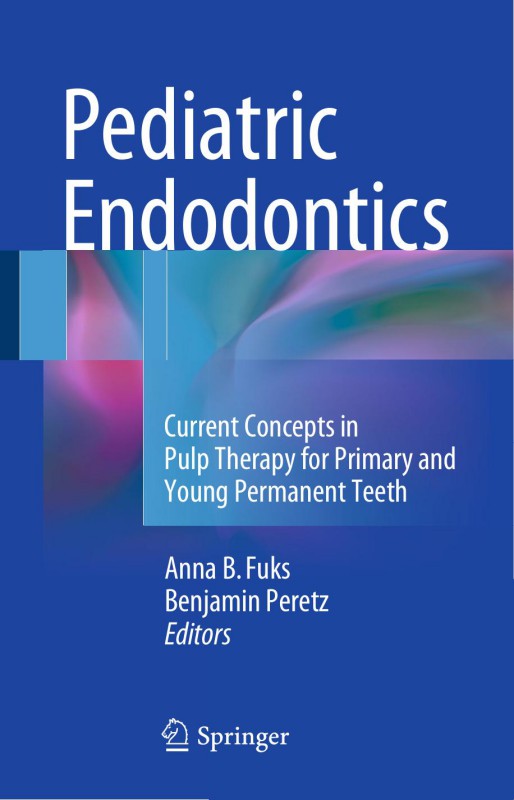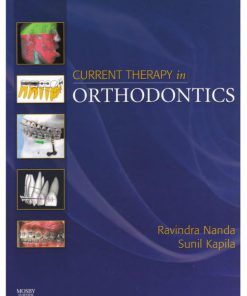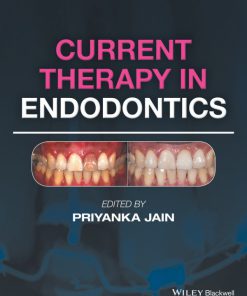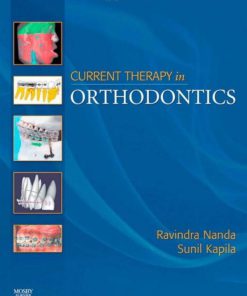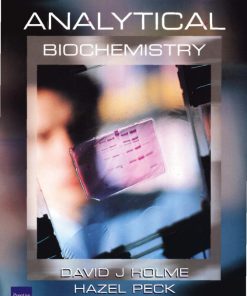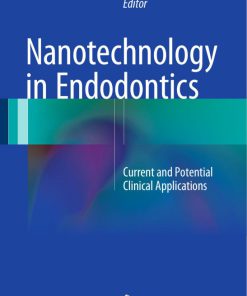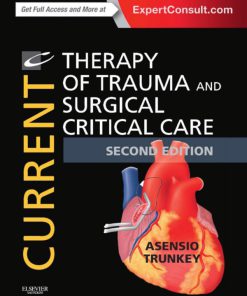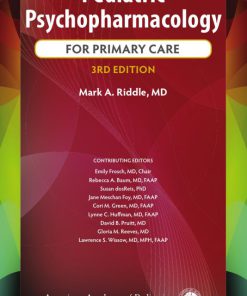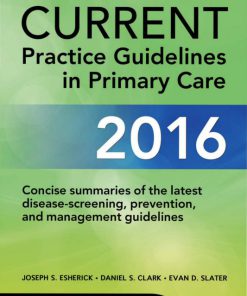Pediatric Endodontics Current Concepts in Pulp Therapy for Primary and Young Permanent Teeth 1st edition by Anna Fuks, Bẹnamin Peretz ISBN 3319275534 97
$50.00 Original price was: $50.00.$25.00Current price is: $25.00.
Authors:Anna Fuks; Benjamin Peretz , Series:Dentistry [171] , Author sort:Fuks, Anna & Peretz, Benjamin , Ids:Goodreads , Languages:Languages:eng , Published:Published:Feb 2016 , Publisher:Springer , Comments:Comments:This book provides dental professionals with a clear understanding of current clinical and scientific knowledge on the various aspects of pulp treatment for both primary and young permanent teeth. Diagnostic parameters are clearly presented, along with step-by-step descriptions of clinical procedures, including indirect and direct pulp treatments, pulpotomy, and pulpectomy. The rationale for the materials used in each technique and their individual merits and disadvantages are examined in detail. In the case of pulpotomy, all the materials used since the introduction of this treatment modality are discussed (e.g., formocresol, glutaraldehyde, ferric sulfate, and MTA) and the roles of sodium hypochlorite, electrofulguration, and laser therapy are elucidated. Special attention is devoted to pulpectomy and root canal treatment, with consideration of debriding and obturation techniques, rinsing solutions, and root-filling pastes. A further individual chapter is dedicated to restorations of teeth treated with the different types of pulp therapy. The various conservative treatment modalities are also presented, including specific treatments for immature nonvital permanent teeth. The concluding chapter looks to the future and the potential value of stem cells in pulp therapy.​
Pediatric Endodontics: Current Concepts in Pulp Therapy for Primary and Young Permanent Teeth 1st edition by Anna Fuks, Bẹnamin Peretz – Ebook PDF Instant Download/Delivery. 3319275534, 978-3319275536
Full download Pediatric Endodontics: Current Concepts in Pulp Therapy for Primary and Young Permanent Teeth 1st Edition after payment

Product details:
ISBN 10: 3319275534
ISBN 13: 978-3319275536
Author: Anna Fuks, Bẹnamin Peretz
Pediatric Endodontics: Current Concepts in Pulp Therapy for Primary and Young Permanent Teeth 1st Table of contents:
1. Pediatric Endodontics: Past and Present Perspectives and Future Directions
- 1.1 Pediatric Endodontics
- 1.2 Historical Perspective
- 1.3 The Scope of the Book
- 1.4 The Aim of the Book
- References
2. The Primary Pulp: Developmental and Biomedical Background
- 2.1 Introduction
- 2.2 Formation of the Dentin–Pulp Complex
- 2.3 The Dental Pulp
- 2.3.1 Odontoblasts
- 2.4 Dentin Structure and Composition
- 2.4.1 Types of Dentin
- 2.5 Factors Affecting the Dentin–Pulp Complex Response to Stimuli in Primary Teeth
- 2.6 The Deleterious Effects of Bacterial Infiltration at the Restorative Material Margins
- 2.7 The Protective Role of the Remaining Dentin Thickness (RDT)
- 2.8 Clinical Recommendations
- References
3. Clinical Pulpal Diagnosis
- 3.1 Medical History
- 3.2 Extra- and Intraoral Examination
- 3.3 Pain Characteristics
- 3.4 Sensibility Tests
- 3.5 Preoperative Diagnosis of Deep Caries Lesions
- 3.6 Operative Diagnosis
- 3.7 Trauma
- 3.8 Correlation Between Histopathologic Status of the Pulp and Deep Caries
- 3.9 Summary
- References
4. Indirect Pulp Treatment, Direct Pulp Capping, and Stepwise Caries Excavation
- 4.1 Purpose of Chapter
- 4.1.1 Goal: To Use IPT Vital Pulp Treatment to Preserve Pulp Vitality
- 4.2 Definitions (See Chapter 2 for Details)
- 4.3 The Dental Caries Process
- 4.4 Methods of Caries Excavation
- 4.4.1 Complete Excavation
- 4.4.1.1 Complete Excavation and Rate of Pulp Exposure
- 4.4.1.2 Complete Excavation and Direct Pulp Capping for Primary Teeth
- 4.4.1.3 Complete Excavation and Direct Pulp Capping for Permanent Teeth
- 4.4.2 Stepwise Caries Excavation (SW)
- 4.4.3 Partial (Incomplete) Caries Excavation
- 4.4.4 No Caries Excavation
- 4.4.1 Complete Excavation
- 4.5 Indirect Pulp Treatment (IPT)
- 4.5.1 Indirect Pulp Treatment Procedure
- 4.5.2 Studies on IPT Success
- 4.6 Reaching the Correct Pulpal Diagnosis
- 4.6.1 Interim Therapeutic Restoration (ITR) for Pulpal Diagnosis
- 4.7 IPT Liners for Pulpal Floor Bases
- Conclusions
- References
5. Pulpotomy Techniques: Cervical (Traditional) and Partial
- 5.1 Introduction
- 5.2 The Importance of Diagnosis and Evaluation Prior to Treatment Selection
- 5.3 Pulpotomy Technique for Primary Teeth
- 5.4 Pulpotomy Materials
- 5.5 Classification of Vital Pulp Therapy
- 5.6 Devitalizing
- 5.6.1 Formocresol
- 5.6.1.1 Formocresol Pulpotomy Technique
- 5.6.1 Formocresol
- 5.7 Preserving
- 5.7.1 Glutaraldehyde
- 5.7.1.1 Glutaraldehyde Pulpotomy Technique
- 5.7.2 Ferric Sulfate
- 5.7.2.1 Internal Resorption Associated with Ferric Sulfate
- Ferric Sulfate Pulpotomy Technique
- 5.7.3 Sodium Hypochlorite
- 5.7.3.1 Sodium Hypochlorite Pulpotomy Technique
- 5.7.1 Glutaraldehyde
- 5.8 Regenerating
- 5.8.1 Calcium Hydroxide
- 5.8.1.1 Calcium Hydroxide Pulpotomy Technique
- 5.8.2 Mineral Trioxide Aggregate (MTA)
- 5.8.2.1 MTA Pulpotomy Technique
- 5.8.1 Calcium Hydroxide
- 5.9 Partial Pulpotomy Secondary to Trauma or Non-caries-Associated Resorption
- 5.10 Summary
- References
6. Pulpectomy and Root Canal Treatment (RCT) in Primary Teeth: Techniques and Materials
- 6.1 Introduction
- 6.2 Morphological Considerations
- 6.3 Primary Tooth Root Canal Physiology and Anomalies
- 6.4 Pulpal and Periapical Diagnostics
- 6.5 Indications and Contraindications for RCT in Primary Teeth
- 6.6 Root Canal Treatment (RCT) Techniques
- 6.6.1 Access and Debridement
- 6.6.2 Irrigation
- 6.6.3 Filling the Canal(s)
- 6.7 Root Canal Filling Materials
- 6.8 Supplementary Methods
- 6.9 Evaluation of RCT
- 6.9.1 Postoperative Radiographic Evaluation
- 6.9.2 Antibiotics in Endodontics
- 6.9.3 Degree of Root Resorption After Root Canal Treatments
- 6.10 Adverse Effects of Root Canal Treatments in Primary Teeth
- 6.10.1 RCT in Canines and Incisors
- 6.10.2 Metal Post
- 6.10.3 Lentulo Spiral Fillers
- 6.10.4 Turner Tooth
- 6.11 Case: Root Canal Treatment in a Primary Molar
- References
7. Restoration of Pulp-Treated Teeth
- 7.1 Introduction
- 7.2 Anterior Restorations (Primary Dentition)
- 7.2.1 Stainless Steel Crowns
- 7.2.2 Pre-veneered Stainless Steel Crowns
- 7.2.3 Strip Crowns
- 7.2.4 Zirconia Crowns
- 7.3 Posterior Restorations (Primary Dentition)
- 7.3.1 Stainless Steel Crowns
- 7.3.2 Pre-veneered Stainless Steel Crowns
- 7.3.3 Resin-Based Restorations
- 7.3.4 Zirconia
- 7.4 Restoration Outcomes on Children Treated Under General Anesthesia
- 7.5 Posterior Restorations (Permanent Dentition)
- References
8. Pulp Therapy for the Young Permanent Dentition
- 8.1 The Pulp-Dentin Complex in Young Permanent Teeth
- 8.2 Clinical Pulpal Diagnosis in Young Permanent Teeth
- 8.2.1 Medical and Dental History
- 8.2.2 Clinical Examination
- 8.2.3 Radiographic Examination
- 8.2.4 Direct Pulp Evaluation
- 8.3 Vital Pulp Therapy for Normal Pulp or Reversible Pulpitis Without Pulp Exposure
- 8.3.1 Indirect Pulp Treatment (IPT)
- 8.4 Vital Pulp Therapy for Normal Pulp or Reversible Pulpitis With Pulp Exposure
- 8.4.1 Direct Pulp Capping
- 8.4.1.1 Direct Pulp Capping Technique
- 8.4.2 Pulpotomy
- 8.4.2.1 Partial (Cvek) Pulpotomy Technique
- 8.4.2.2 Cervical (Full) Pulpotomy
- Follow-up After Vital Pulp Therapy
- 8.4.1 Direct Pulp Capping
- 8.5 Nonvital Pulp Treatment for Immature Teeth
- 8.5.1 Apexification
- 8.5.1.1 Long Term Apexification with Calcium Hydroxide
- Calcium Hydroxide Apexification Technique
- 8.5.1.2 Short Term Apexification with MTA (One Visit Apexification)
- MTA Apexification Technique
- 8.5.1.1 Long Term Apexification with Calcium Hydroxide
- 8.5.2 Pulp Revascularization and Regeneration
- 8.5.2.1 Revascularization Clinical Procedure
- Case Selection
- Informed Consent
- 8.5.2.2 First Appointment
- Disinfection of the Root Canal Space
- 8.5.2.3 Second Appointment (2–4 Weeks After 1st Appointment)
- Scaffold
- 8.5.2.4 Follow Up
- 8.5.1 Apexification
- 8.6 Nonvital Pulp Treatment (Root Canal Treatment) for Young Mature Teeth
- 8.6.1 Special Considerations
- 8.6.1.1 Access Opening
- 8.6.1.2 Instrumentation
- 8.6.1.3 Irrigation
- 8.6.1.4 Intracanal Dressing
- 8.6.1.5 The Isthmus
- 8.6.1.6 Obturation
- 8.6.1 Special Considerations
- References
9. The Future: Stem Cells and Biological Approaches for Pulp Regeneration
- 9.1 Introduction
- 9.2 Pulp Therapy in Primary and Young Permanent Teeth
- 9.3 Regeneration of the Dental Pulp
- 9.4 Growth and Differentiation Factors
- 9.5 Scaffolds
- 9.6 Tissue Engineering in Endodontics
- 9.7 Approaches for Regenerative Endodontics
- 9.7.1 Root Canal “Revascularization” via Blood Clotting
- 9.7.2 Postnatal Stem Cell Therapy Using Injectable Scaffolds
- 9.7.3 Pulp Transplantation Using Stem Cells Grown in Sheets
People also search for Pediatric Endodontics: Current Concepts in Pulp Therapy for Primary and Young Permanent Teeth 1st:
recent advances in pediatric endodontics
pediatric endodontics near me
intracanal irrigants in pediatric endodontics a review
materials used in pediatric endodontics
anna fuks pediatric endodontics

